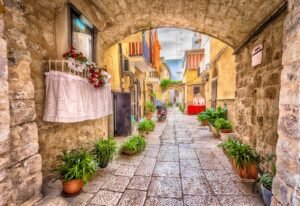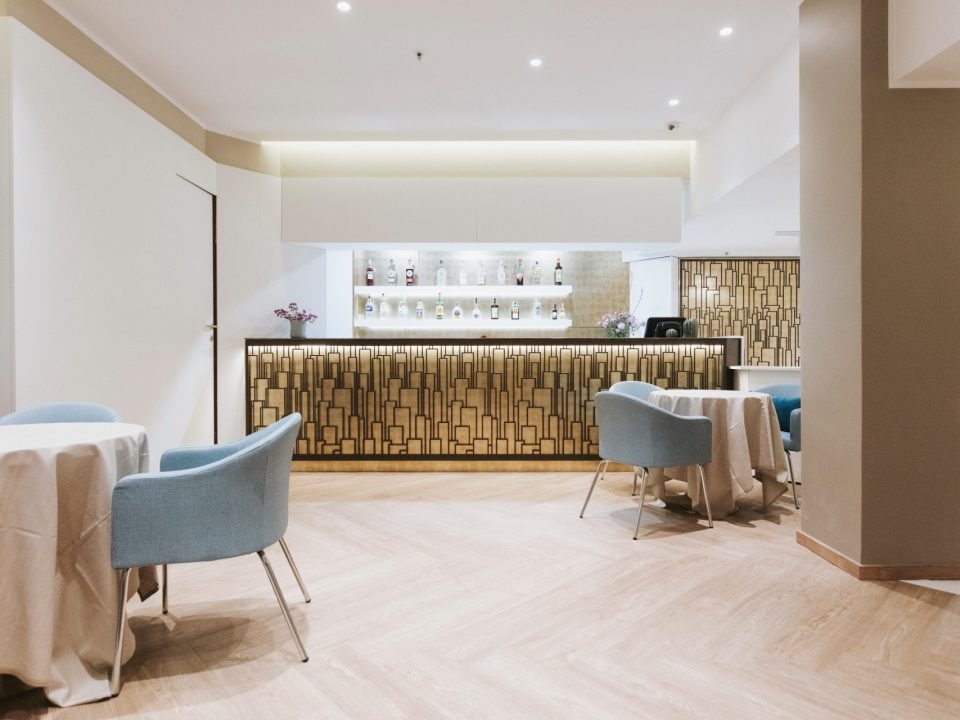Bari welcomes the visitor with its history rich in tradition and folklore. The large port, the seafront and the historic centre where ancient trades still live are the bulwarks of a proud identity that survives through the centuries and allows itself to be discovered by those willing to explore it carefully and with care.
Bari

Bari, a city with a strong port vocation and a hub for contacts and trade with the Middle East, overlooks the Adriatic Sea, where the city port is located and is the largest Italian port of call on the Adriatic. Its territory embraces the valley of the Bari basin, reaching as far as the borders of the Murge. For the sake of convenience, the city can be divided into areas of interest: the old town, criss-crossed by narrow streets and alleyways populated by palaces, houses and basses where historical sites such as the Cathedral of San Nicola, the church of San Sabino and the orecchiette (ear-shaped pasta) street are located; the modern city, built after 1813 during the reign of Joachim Murat, which is characterised by wide streets that meet at right angles and house shops and offices; the industrial area, the most peripheral part of the city destined for manufacturing activities. Since 1930, Bari, an ancient city and for centuries a junction between East and West, has hosted the Fiera del Levante, which every year brings together the most important players in industry and commerce.
The city of Bari, with its history and ancient cultural traditions, holds pleasant surprises in store for all travellers who wish to discover its most authentic and genuine face. One of these is its historical centre, known as 'Bari Vecchia'. It is here that, among intertwining narrow streets and stone-paved alleys, a small universe of art, folklore and civil and religious identity comes to life. Crossing Bari Vecchia means coming across millenary buildings, encountering ancient trades and appreciating the sounds and colours typical of the lively atmosphere of yesteryear. There are many points of interest, here are some of the most significant: the basilica of San Nicola, dedicated to one of Italy's most venerated saints whose remains it houses. Built in Apulian-Romanesque style, it is located on the large square separating the old town from the seafront. The building, built from the 11th century onwards, is a world-famous pilgrimage destination and both the exterior and interior still retain its original and imposing beauty; the cathedral of San Sabino, also in Apulian-Romanesque style, was built between the 12th and 13th centuries and is famous for its bell tower whose silhouette is visible from the entire seafront. Inside, the ancient women's galleries, the pulpit and the crypt of great artistic value can still be seen; the Castle of the Norman era, also worth a visit: a 13th-century fortress, it is one of the main symbols of the city; the wall and the Fortino di Sant'Antonio Abate, which is one of the four bastions of the city walls; the famous 'via delle orecchiette' at Via dell'Arco Basso (accessed by crossing a low stone arch). This is one of the best known streets in Bari Vecchia. Here you can see the local housewives intent on making orecchiette, Apulian pasta par excellence, by hand, skilfully kneading and shaping the dough with true mastery. All under the eyes of tourists and locals who can appreciate this ancient art up close.
Bari offers a wide variety of typical dishes that testify to the ancient local gastronomic traditions and preserve the Mediterranean flavours of the past. One of the typical products (which characterises the whole of Apulia) is olive oil obtained from the olive groves that populate the region: this condiment is best enjoyed raw, on soups, bruschettas and salads that will take on an enveloping and intense flavour. During aperitifs or as an appetiser, taralli are a must and you can find them in many variations. As first courses, handmade orecchiette pasta with sauce or the traditional turnip tops, as well as cavatelli or lagane, also handmade, are worth tasting. Another speciality is tiella with potatoes, rice and mussels, with an intense and rich flavour. Typical of local street food, then, are the calzoni stuffed with onion, anchovies and capers and the fried panzerotti stuffed with lard and ricotta cheese. Also not to be missed is the Bari focaccia, with its unmistakable dough made of potatoes and olive oil. Meat lovers will be able to experience the 'ghiemmerìidde', tasty lamb roulades, rabbit and game dishes and the characteristic thrushes in sauce preserved in white wine. Broad beans with chicory, a traditional peasant dish, are excellent with a local red wine. For fish dishes, we find the famous linguine with sea urchins or the raw fish, which, with their delicate yet decisive flavour, are a true gastronomic excellence. Finally, royal pastas, castagnèdde and sassanìidde can be the sweet conclusion to any meal.
One of the most famous events held in Bari is undoubtedly La Fiera del Levante in September. Established in 1930 and suspended only twice (from 1940 to 1946 during the Second World War and in 2021 due to the Coronavirus pandemic), it involves thousands of national and international exhibitors every year and aims to encourage meetings and exchanges between East and West. Another very important event is the feast of the patron saint, St Nicholas: the festivities last from 7 to 9 May and see large numbers of pilgrims from all over the world flock to worship the saint. On the evening of the eve, a historical procession with marching bands takes place, while on the day of the feast, a procession is held to carry the statue of the saint to the St Nicholas Pier. Among the city's most prestigious events is the Bari International Film Festival (Bif&st), an international festival of cinema and audiovisual culture. The Bif&st is promoted by the Apulia Region and does not have a fixed date, but changes from year to year.





